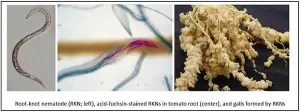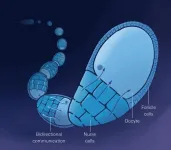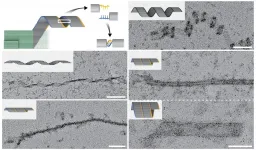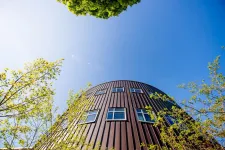Phytol may be promising for eco-friendly agrochemicals to control root-knot nematodes
2021-03-22
(Press-News.org) Root-knot nematodes (RKNs, Meloidogyne spp.) infect a broad range of plants, including several agriculturally important species such as cotton, soybean and corn, as well as various vegetables and ornamentals. These parasites cause roots to develop galls that result in severe plant damage and, ultimately, important crop losses. Growers currently use synthetic nematicides to manage RKNs; however, these compounds are detrimental to the microbial diversity of soil and harmful for the environment. Thus, it is necessary to develop alternative sustainable control methods.
"We have been seeking natural compounds that activate plant defense systems and do not have direct nematicidal activity using the combination of RKNs and their host plants," explained Shigemi Seo, researcher at the National Institute of Agrobiological Sciences of Japan. "We were most excited to discover that phytol, a chlorophyll constituent, has an inhibitory effect on the root invasion by a certain harmful plant nematode without killing it. We did not expect this molecule to be involved in RKN resistance."
"We noticed that plant leaves discolored yellow or pale green when their roots were parasitized by RKNs and confirmed a decrease in chlorophyll content in such leaves. We hypothesized that chloroplast-related compounds would accumulate in RKN-parasitized roots and induce the host defense against RKNs. We analyzed root metabolites and found accumulation of phytol, a constituent of chlorophyll. When phytol was applied to plant roots, RKN invasion of the roots was inhibited. This inhibition was not due to the direct nematicidal activity of phytol, since this compound did not kill RKNs," added Seo.
Even though phytol has been known for several years as a constituent of chlorophyll and is a ubiquitous compound present in almost all photosynthetic organisms, its role as a plant defense-signaling molecule remained unexplored. "Phytol may be a promising material for eco-friendly agrochemicals for the control of RKNs. We are currently investigating its effects on not only other plant parasitic nematodes but also other pathogenic microorganisms."
For more information about this study, read "Phytol, a Constituent of Chlorophyll, Induces Root-Knot Nematode Resistance in Arabidopsis via the Ethylene Signaling Pathway" in the MPMI journal.
INFORMATION:
[Attachments] See images for this press release:

ELSE PRESS RELEASES FROM THIS DATE:
2021-03-22
A team of scientists at the University of Massachusetts Amherst have developed the thinnest and most sensitive flow sensor, which could have significant implications for medical research and applications, according to new research published recently in Nature Communications.
The research was led by Jinglei Ping, assistant professor of mechanical and industrial engineering, along with a trio of mechanical engineering Ph.D. students: Xiaoyu Zhang, who fabricated the sensor and made the measurement, Eric Chia and Xiao Fan. The findings pave the way for future research on all-electronic, in-vivo flow monitoring in investigating ...
2021-03-22
A cast of so-called 'nurse cells' surrounds and supports the growing fruit fly egg during development, supplying the egg -- or 'oocyte' -- with all the nutrients and molecules it needs to thrive. Long viewed as passive in this process, the Drosophila egg actually plays an active role not only in its own growth, but also in the growth of the surrounding nurse cells, Princeton University researchers report on March 21 in Developmental Cell.
"Here we show an example of bidirectional communication -- a dialogue -- between different cells. The egg is taking an active hand in controlling its own feeding ...
2021-03-22
Scientists from the Department of Physiology of the University of Granada (UGR) have shown that caffeine (about 3 mg/kg, the equivalent of a strong coffee) ingested half an hour before aerobic exercise significantly increases the rate of fat-burning. They also found that if the exercise is performed in the afternoon, the effects of the caffeine are more marked than in the morning.
In their study, published in the Journal of the International Society of Sports Nutrition, the researchers aimed to determine whether caffeine--one of the most commonly-consumed ergogenic substances in ...
2021-03-22
LAWRENCE -- When a franchise buys a superstar like Tom Brady or LeBron James, the team tends to win more games. But do the fans follow? How much team loyalty is purchased along with an expensive star? Maybe not as much as some owners might hope -- in the NBA Finals between the Miami Heat and San Antonio Spurs, many fans expressed their dislike of the "bought" Miami team.
In a new paper published in the peer-reviewed Journal of Applied Social Psychology, researchers at the University of Kansas asked over 1,500 Americans how much they liked teams that purchased excellence and compared that with liking teams that built excellence from the ground up.
"People reliably ...
2021-03-22
An international team of scientists from Nanyang Technological University, Singapore (NTU Singapore), Brown University and the Massachusetts Institute of Technology (MIT) has developed an artificial intelligence (AI) platform that could one day be used in a system to assess vascular diseases, which are characterised by the abnormal condition of blood vessels.
The AI-powered platform combines machine learning and a specially-designed microfluidic chip with analysis of 2D video images of blood flow and the application of physical laws, to infer how blood flows in 3D. In tests, it accurately predicted blood flow characteristics such as speed, pressure, and shear stress, ...
2021-03-22
The world needs more electricity. As populations grow, standards of living increase and more people gain access to modern conveniences, countries will need to expand their energy generation capacity.
India, with its rapidly developing economy and a population of more than 1.3 billion, epitomizes this trend. The country finds itself at a crossroads regarding its energy future: Small decisions today will resound in the coming years.
In their latest report, the Indian government set a target of 450 gigawatts of renewable energy capacity by 2030. For comparison, the country's total energy generation capacity today is about 380 gigawatts, out of which 90 gigawatts are of renewable energy, not including large hydropower stations. How this plan shapes up will dictate how ...
2021-03-22
(BOSTON) -- A team of nanobiotechnologists at Harvard's Wyss Institute for Biologically Inspired Engineering and the Dana-Farber Cancer Institute (DFCI) led by Wyss Founding Core Faculty member William Shih, Ph.D., has devised a programmable DNA self-assembly strategy that solves the key challenge of robust nucleation control and paves the way for applications such as ultrasensitive diagnostic biomarker detection and scalable fabrication of micrometer-sized structures with nanometer-sized features. Using the method, called "crisscross polymerization", the researchers can initiate weaving ...
2021-03-22
One of the surest signs of spring is the vibrantly lime-green tinge trees develop as their buds open and tiny new leaves unfurl. Bud-break is the scientific name for this process -- a straightforward term for the grand genetic mechanism that allows trees to leaf out and do their summer work of photosynthesis to store up energy for the coming winter.
Bud-break is precluded by bud-set, which occurs in the autumn. After trees have dropped their leaves and as the days shorten and grow colder, new buds grow on branches. Like many wildflowers, trees require a period of dormancy at colder temperatures -- a process fine-tuned by evolution ...
2021-03-22
DURHAM, N.C. -An unfortunate biological "feed-forward" loop drives cartilage cells in an arthritic joint to actually contribute to progression of the disease, say researchers at Duke University and Washington University in Saint Louis.
Pain researcher and mechanobiologist Wolfgang Liedtke, a professor of neurology at Duke, partnered with former Duke colleague and cartilage expert Farshid Guilak, now at the Washington University School of Medicine, to examine the activity of pressure-sensitive ion channels in cartilage. Their study appears the week of March 22 in the Proceedings of the National Academy of Sciences.
Cartilage is the highly lubricated, low-friction, elastic tissue that lines ...
2021-03-22
There are 12 essential attributes that explain why commercial carbon capture and sequestration projects succeed or fail in the U.S., University of California San Diego researchers say in a recent study published in Environmental Research Letters.
Carbon capture and sequestration (CCS) has become increasingly important in addressing climate change. The Intergovernmental Panel on Climate Change (IPCC) relies greatly on the technology to reach zero carbon at low cost. Additionally, it is among the few low-carbon technologies in President Joseph R. Biden's proposed $400 billion clean energy plan that earns bipartisan support.
In the last two decades, private industry and government have ...
LAST 30 PRESS RELEASES:
[Press-News.org] Phytol may be promising for eco-friendly agrochemicals to control root-knot nematodes





